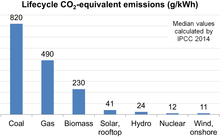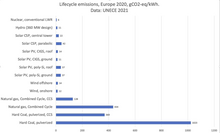
Electric power systems consist of generation plants of different energy sources, transmission networks, and distribution lines. Each of these components can have environmental impacts at multiple stages of their development and use including in their construction, during the generation of electricity, and in their decommissioning and disposal. These impacts can be split into operational impacts and construction impacts. All forms of electricity generation have some form of environmental impact, but coal-fired power is the dirtiest. This page is organized by energy source and includes impacts such as water usage, emissions, local pollution, and wildlife displacement.

Energy is sustainable if it "meets the needs of the present without compromising the ability of future generations to meet their own needs." Most definitions of sustainable energy include considerations of environmental aspects such as greenhouse gas emissions and social and economic aspects such as energy poverty. Renewable energy sources such as wind, hydroelectric power, solar, and geothermal energy are generally far more sustainable than fossil fuel sources. However, some renewable energy projects, such as the clearing of forests to produce biofuels, can cause severe environmental damage.

A fossil fuel power station is a thermal power station which burns a fossil fuel, such as coal or natural gas, to produce electricity. Fossil fuel power stations have machinery to convert the heat energy of combustion into mechanical energy, which then operates an electrical generator. The prime mover may be a steam turbine, a gas turbine or, in small plants, a reciprocating gas engine. All plants use the energy extracted from the expansion of a hot gas, either steam or combustion gases. Although different energy conversion methods exist, all thermal power station conversion methods have their efficiency limited by the Carnot efficiency and therefore produce waste heat.
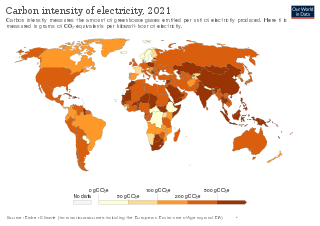
An emission intensity is the emission rate of a given pollutant relative to the intensity of a specific activity, or an industrial production process; for example grams of carbon dioxide released per megajoule of energy produced, or the ratio of greenhouse gas emissions produced to gross domestic product (GDP). Emission intensities are used to derive estimates of air pollutant or greenhouse gas emissions based on the amount of fuel combusted, the number of animals in animal husbandry, on industrial production levels, distances traveled or similar activity data. Emission intensities may also be used to compare the environmental impact of different fuels or activities. In some case the related terms emission factor and carbon intensity are used interchangeably. The jargon used can be different, for different fields/industrial sectors; normally the term "carbon" excludes other pollutants, such as particulate emissions. One commonly used figure is carbon intensity per kilowatt-hour (CIPK), which is used to compare emissions from different sources of electrical power.

Climate change mitigation is action to limit climate change by reducing emissions of greenhouse gases or removing those gases from the atmosphere. The recent rise in global average temperature is mostly due to emissions from burning fossil fuels such as coal, oil, and natural gas. Mitigation can reduce emissions by transitioning to sustainable energy sources, conserving energy, and increasing efficiency. It is possible to remove carbon dioxide from the atmosphere by enlarging forests, restoring wetlands and using other natural and technical processes. Experts call these processes carbon sequestration. Governments and companies have pledged to reduce emissions to prevent dangerous climate change in line with international negotiations to limit warming by reducing emissions.

Nuclear energy policy is a national and international policy concerning some or all aspects of nuclear energy and the nuclear fuel cycle, such as uranium mining, ore concentration, conversion, enrichment for nuclear fuel, generating electricity by nuclear power, storing and reprocessing spent nuclear fuel, and disposal of radioactive waste. Nuclear energy policies often include the regulation of energy use and standards relating to the nuclear fuel cycle. Other measures include efficiency standards, safety regulations, emission standards, fiscal policies, and legislation on energy trading, transport of nuclear waste and contaminated materials, and their storage. Governments might subsidize nuclear energy and arrange international treaties and trade agreements about the import and export of nuclear technology, electricity, nuclear waste, and uranium.

Carbon capture and storage (CCS) is a process in which a relatively pure stream of carbon dioxide (CO2) from industrial sources is separated, treated and transported to a long-term storage location. For example, the carbon dioxide stream that is to be captured can result from burning fossil fuels or biomass. Usually the CO2 is captured from large point sources, such as a chemical plant or biomass plant, and then stored in an underground geological formation. The aim is to reduce greenhouse gas emissions and thus mitigate climate change.

Greenhouse gas emissions from human activities strengthen the greenhouse effect, contributing to climate change. Most is carbon dioxide from burning fossil fuels: coal, oil, and natural gas. The largest emitters include coal in China and large oil and gas companies. Human-caused emissions have increased atmospheric carbon dioxide by about 50% over pre-industrial levels. The growing levels of emissions have varied, but have been consistent among all greenhouse gases. Emissions in the 2010s averaged 56 billion tons a year, higher than any decade before.

Ensuring adequate energy supply to sustain economic growth has been a core concern of the Chinese government since 1949. The country is the world's largest emitter of greenhouse gases, and coal in China is a major cause of global warming. However, from 2010 to 2015 China reduced energy consumption per unit of GDP by 18%, and CO2 emissions per unit of GDP by 20%. On a per-capita basis, it was the world's 51st largest emitter of greenhouse gases in 2016. China is also the world's largest renewable energy producer. China is the largest producer of hydroelectricity, solar power and wind power in the world. The energy policy of China is connected to its industrial policy. The goals of China's industrial policy dictate its energy needs.

A gas-fired power plant is a thermal power station that burns natural gas to generate electricity. Gas-fired power plants generate almost a quarter of world electricity and are significant sources of greenhouse gas emissions. However, they can provide seasonal, dispatchable energy generation to compensate for variable renewable energy deficits, where hydropower or interconnectors are not available.
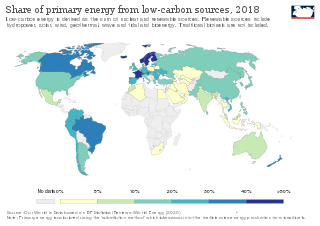
Low-carbon power is electricity produced with substantially lower greenhouse gas emissions than conventional fossil fuel power generation. The energy transition to low-carbon power is one of the most important actions required to limit climate change. Power sector emissions may have peaked in 2018. During the first six months of 2020, scientists observed an 8.8% decrease in global CO2 emissions relative to 2019 due to COVID-19 lockdown measures. The two main sources of the decrease in emissions included ground transportation (40%) and the power sector (22%). This event is the largest absolute decrease in CO2 emissions in history, but emphasizes that low-carbon power "must be based on structural and transformational changes in energy-production systems".

Mark Zachary Jacobson is a professor of civil and environmental engineering at Stanford University and director of its Atmosphere/Energy Program. He is also a co-founder of the non-profit, Solutions Project.

A fuel is any material that can be made to react with other substances so that it releases energy as thermal energy or to be used for work. The concept was originally applied solely to those materials capable of releasing chemical energy but has since also been applied to other sources of heat energy, such as nuclear energy.
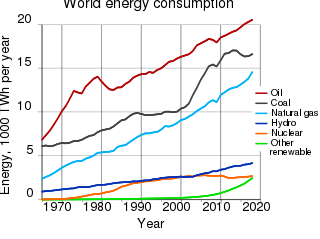
The environmental impact of the energy industry is significant, as energy and natural resource consumption are closely related. Producing, transporting, or consuming energy all have an environmental impact. Energy has been harnessed by human beings for millennia. Initially it was with the use of fire for light, heat, cooking and for safety, and its use can be traced back at least 1.9 million years. In recent years there has been a trend towards the increased commercialization of various renewable energy sources. Scientific consensus on some of the main human activities that contribute to global warming are considered to be increasing concentrations of greenhouse gases, causing a warming effect, global changes to land surface, such as deforestation, for a warming effect, increasing concentrations of aerosols, mainly for a cooling effect.
Different methods of electricity generation can incur a variety of different costs, which can be divided into three general categories: 1) wholesale costs, or all costs paid by utilities associated with acquiring and distributing electricity to consumers, 2) retail costs paid by consumers, and 3) external costs, or externalities, imposed on society.

The long tailpipe is an argument stating that usage of electric vehicles does not always result in fewer emissions compared to those from non-electric vehicles. While the argument acknowledges that plug-in electric vehicles operating in all-electric mode have no greenhouse gas emissions from the onboard source of power, it claims that these emissions are shifted from the vehicle tailpipe to the location of the electrical generation plants. From the point of view of a well-to-wheel assessment, the extent of the actual carbon footprint depends on the fuel and technology used for electricity generation, as well as the impact of additional electricity demand on the phase-out of fossil fuel power plants.

The Afşin-Elbistan power stations are coal-fired power stations in Afşin in Kahramanmaraş Province in Turkey. The area is a sulfur dioxide air pollution hotspot: Air pollution can be trapped by the surrounding mountains, and Greenpeace say that measurements they took nearby in late 2020 show illegal levels of particulates and nitrogen oxides. The Environment Ministry has not released the flue gas measurements.
Afşin-Elbistan C was a planned 1800-MW coal-fired power station which was proposed to be built in Turkey by the state-owned mining company Maden Holding. Estimated to cost over 17 billion lira, at planned capacity it would have generated about 3% of the nation's electricity. According to the environmental impact assessment (EIA) the plant would have burned 23 million tonnes of lignite annually, and emit over 61 million tonnes of CO2 each year for 35 years.

Coal in Turkey generates between a quarter and a third of the nation's electricity. There are 53 active coal-fired power stations with a total capacity of 21 gigawatts (GW).
